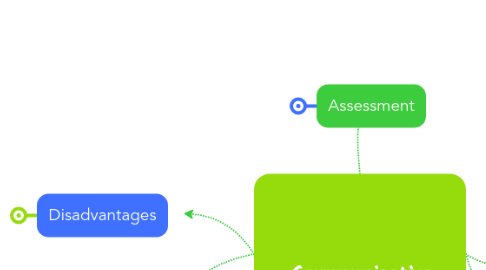
1. Disadvantages
1.1. It pays insufficient attention to the context in which teaching and learning take place
1.1.1. The Communicative Approach often seems to be interpreted as: “if the teacher understands the student we have good communication” but native speakers of the target language can have great difficulty understanding students.
1.1.1.1. Another disadvantage is that the CLT approach focuses on fluency but not accuracy. The approach does not focus on error reduction but instead creates a situation where learners are left using their own devices to solve their communication problems. Thus they may produce incoherent, grammatically incorrect sentences.
2. Advantages
2.1. Communicative approach is much more pupil-orientated, because it is based on pupils’ needs and interests.
2.1.1. Communicative approach seeks to personalise and localise language and adapt it to interests of pupils. Meaningful language is always more easily retained by learners.
2.1.1.1. Seeks to use authentic resources. And that is more interesting and motivating for children.
2.1.1.1.1. Children acquire grammar rules as a necessity to speak so is more proficient and efficient.
3. Assessment
3.1. Test how learning is going
3.2. Identify areas for improvements
3.3. Conducted during the learning process
3.4. Help students to learn from each other
4. Main components
4.1. 1. Language is a system for the expression of meaning. 2. The primary function of language is for interaction and communication. 3. The structure of language reflects its functional and communicative uses. 4. The primary units of language are not merely its grammatical and structural features, but categories of functional and communicative meaning as exemplified in discourse.
5. Learner roles
5.1. The emphasis in Communicative Language Teaching on the processes of communication, rather than mastery of language.
6. Teacher roles
6.1. The first role is to facilitate the communication process between all participants in the classroom, and between these participants and the various activities and texts;
6.1.1. The second role is to act as an independent participant within the learning-teaching group.
7. Exercises
7.1. Role Plays
7.1.1. The Talk Show Interview
7.1.1.1. Objectified
7.1.1.1.1. What I YouTubed Last Weekend
